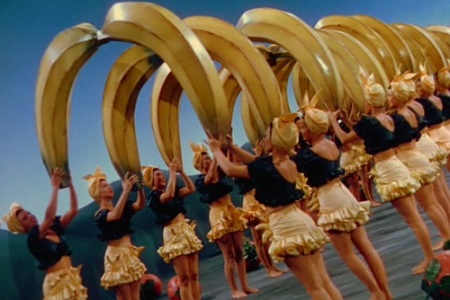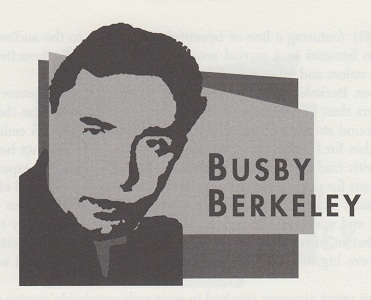Born: November 29, 1895, Los Angeles, CA
Died: March 14, 1976, Palm Springs, CA
Jesus, now Berkeley’s going through the roof!
—Sam Warner
The U.S. Army made a choreographer of Busby Berkeley. During World War I, he was assigned to train groups of twelve hundred men for parade drills, and he conducted aerial observations for a small army film unit. Upon his release, Berkeley took his newfound skills to Broadway, where his choreography of five shows in 1928 dazzled the eyes of Sam Goldwyn, who, two years later, brought Berkeley to Hollywood. In just one decade, Busby Berkeley would do much more than show dancers how to move—he would show directors how to move, too.
His first film experience was a musical sequence in Eddie Cantor’s Whoopee! (1930), featuring a young Lucille Ball among a chorus of the Goldwyn Girls. Berkeley designed a grand-scale number using symmetrical formations filmed with some overhead shots. The result was an abstract visual style that would eventually become his favored technique. Employing huge chorus lines, special lighting and mirrors, the Berkeley musicals for MGM and Warner Bros. created an escapism of happiness and prosperity throughout the Depression and into World War II. Even costumes and props got the Berkeley treatment—Ginger Rogers wears a suit of coins as she sings “We’re in the Money” in the opening number of Gold Diggers of 1933, one of the many obvious metaphors that characterized Busby’s work. Freudian symbolism appears in his campy Carmen Miranda vehicle The Gang’s All Here (1943), featuring a line of beautiful girls waving to the audience with overblown bananas in a surreal sequence; the film was a favorite among homesick sailors and GIs.
However, Berkeley’s choreography is important less for its movement of the dancers than for its movement of the camera. To overcome the limitations of sound stages, he ripped out walls and drilled through ceilings and dug trenches for his film crews. When a desired effect could not be accomplished with traditional film equipment, he had his budget expanded to include costs for developing custom rigs. His innovations explored ideas that the stationary camera could not. He wanted to take the audience through waterfalls and windows. He wanted lines of dancers to fall away to reveal scenery that in turn would fall away to expose an even larger setting. His dreams were big, but his determination to see them actualized was even bigger.
Even his worst attempts resulted in eminently watchable movies of exhilarating movement, but his best efforts produced startling effects that bordered on surrealistic dream states. In the quintessential Berkeley films Footlight Parade (1933) and 42nd Street (1933), cameras mounted on tracks are sent soaring past a multitude of dancing legs, flailing arms and orchestra instruments. In all, he directed more than twenty musicals, including an underwater sequence with aquatic star Esther Williams.
The high production costs of his spectacles became a liability when a new breed of sophisticated musicals learned to integrate music and drama, an approach that countered the bravura dance numbers he made famous. Attempting to transition to other directorial assignments, Berkeley suffered a well-publicized nervous breakdown, then retired in the mid-1950s. But he lived long enough to see a revival of his films by an appreciative new generation. Part circus and part stage, his musical numbers becamea staple of the moviegoers’ diet, and other studios were forced to match his flamboyance. Few films, however, ever matched the wonder of a Busby Berkeley production.
To read all the republished articles from ‘The Film 100,’ go to Reintroducing the Film 100 here on Keyframe.





